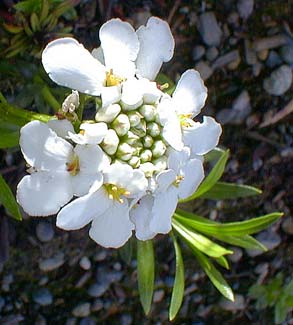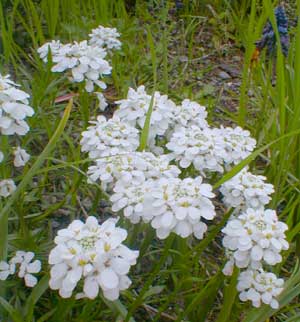
'Snowflake'
Evergreen Candytuff
"In the company of flowers we know happiness."
-John Stewart Collis,
Farewell to the Wood, 1989
Farewell to the Wood, 1989
Candytuft is not named for candy, but for Candia, i.e, Crete, one of the southern European locales where Iberis sempervirens is a common wildflower. Even so, Corymbs of small white flowers age to pinkish & are often thick enough to hide the foliage entirely, so that there is a slight resemblance to a cloud of white cotton candy.
It was first cultivated in England in Elizabethan times, when it was known sometimes as Candy Thlaspy, Candy Turf, or Spanish Tuft, this latter name reflected in the genus name Iberis which is an old name of Spain.
 The cultivar 'Snowflake' is a bit smaller than the species as a whole, & has an unusually bright-white bloom when these are first appearing in Spring. The April photo at page-top is our first candytuft flower of the year 2003, shown at thrice life size. As the photo shows, the corymbs bloom first around the edges & the center buds open last. The second photo is again from April (2005).
The cultivar 'Snowflake' is a bit smaller than the species as a whole, & has an unusually bright-white bloom when these are first appearing in Spring. The April photo at page-top is our first candytuft flower of the year 2003, shown at thrice life size. As the photo shows, the corymbs bloom first around the edges & the center buds open last. The second photo is again from April (2005).We initially planted two of the tiniest worn-out pots of candytuft rather late in 2002, obtained at a "leftover perennials sale," so by spring 2003 these little patches were still only barely getting established. By the next spring after that, the two plantings had become sizeable clumps, blooming even earlier in April with a couple minor flashes of flower late March, & lasting well into May.
As a subshrub with early to late spring bloom, it can shrub up to a foot high or so, or spill over a ledge. It looks good gone semi-wild amidst naturalized sillas & grape hyacinths when they are all in early spring blossom together, or (as in our case) to have it still blooming when the majority of species tulips are appearing. Then when early & mid-spring bulbs go dormant in the hot months, the candytuff remains as a pleasant evergreen so that the location never goes bare.
It also looks good with a similarly flowery subshrub of about the same size, Alpine Wallflower (Erysimum linifolium), which will have bright orange & red & maroon flowers in extreme contrast to the Candytuft's white.
In warmer zones Candytuft will be fully evergreen, but in zone 7 or below it will be a die-back perennial. Even here in zone 8 it gets a bit of frost damage in some cold-snap years, & sometimes but not invariably demands a winter's-end shearing to remove damaged bits & make room for new growth.
When it is done blooming just before summer, it can more certainly stand to be sheered by as much as one-third to preserve a compact form. If never pruned it will eventually spread out a bit & show some horizontal legginess, which isn't invariably a bad appearance, but with post-flower sheering it can be maintained as a much more formal mound. The second photo shows how candytuft gets if not pruned for a couple of years, quite the opposite of formal but very nice even with neglect.
It can slowly spread itself into a groundcover if not annually sheered, for wherever its branches touch the ground they tend to take root. If there's no room for it to spread, the self-rooted edges can be sliced out of the clump to transplant elsewhere or to pot up & give as gifts.
Very drought tolerant, it is ideal for a neglected spot because it thrives in poor soil & prefers to be rarely watered. About the only thing that will kill it is too much dampness. A spot with best drainage in bright sun suits it. It may survive but will not bloom so intensely in shade.